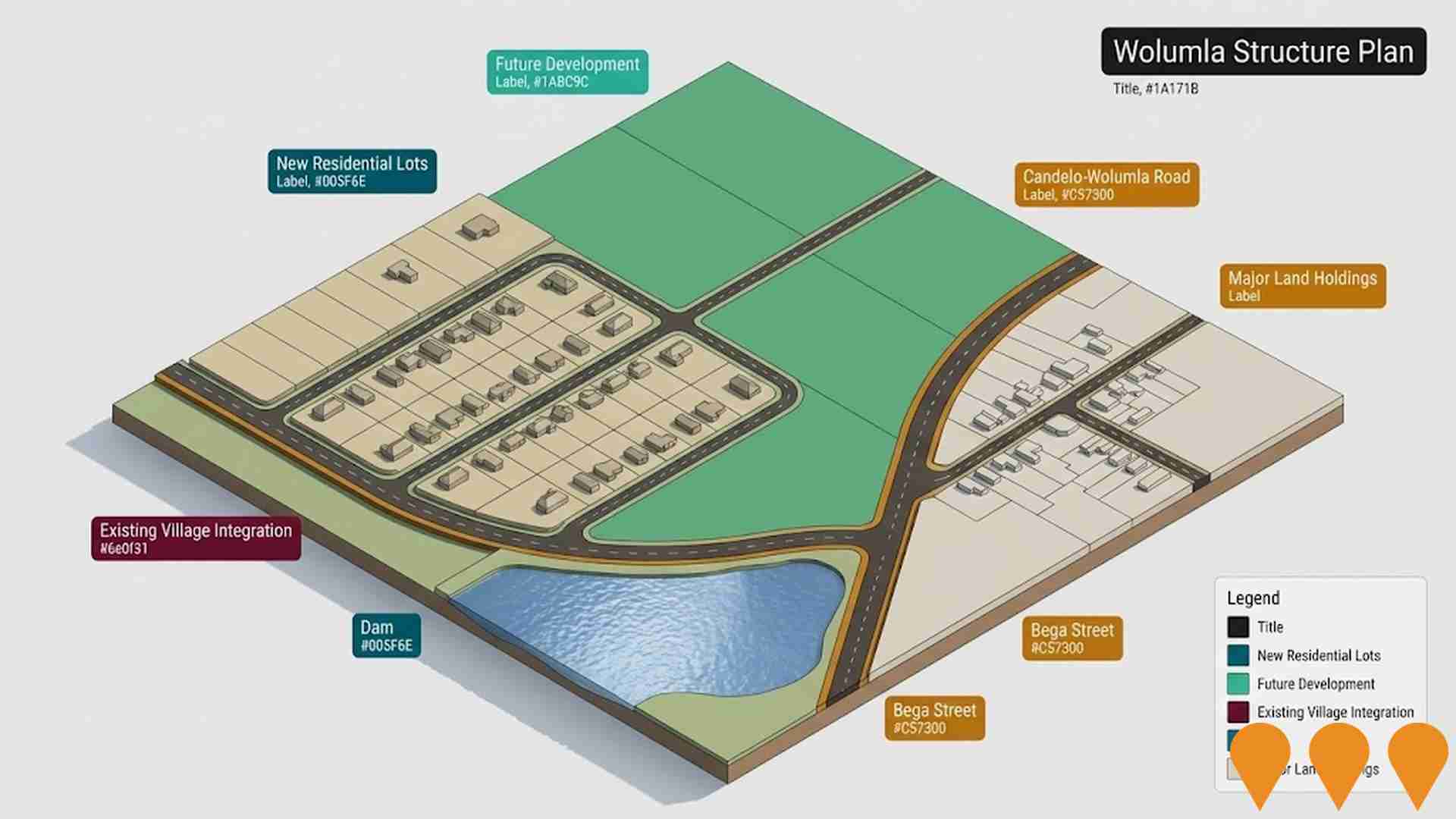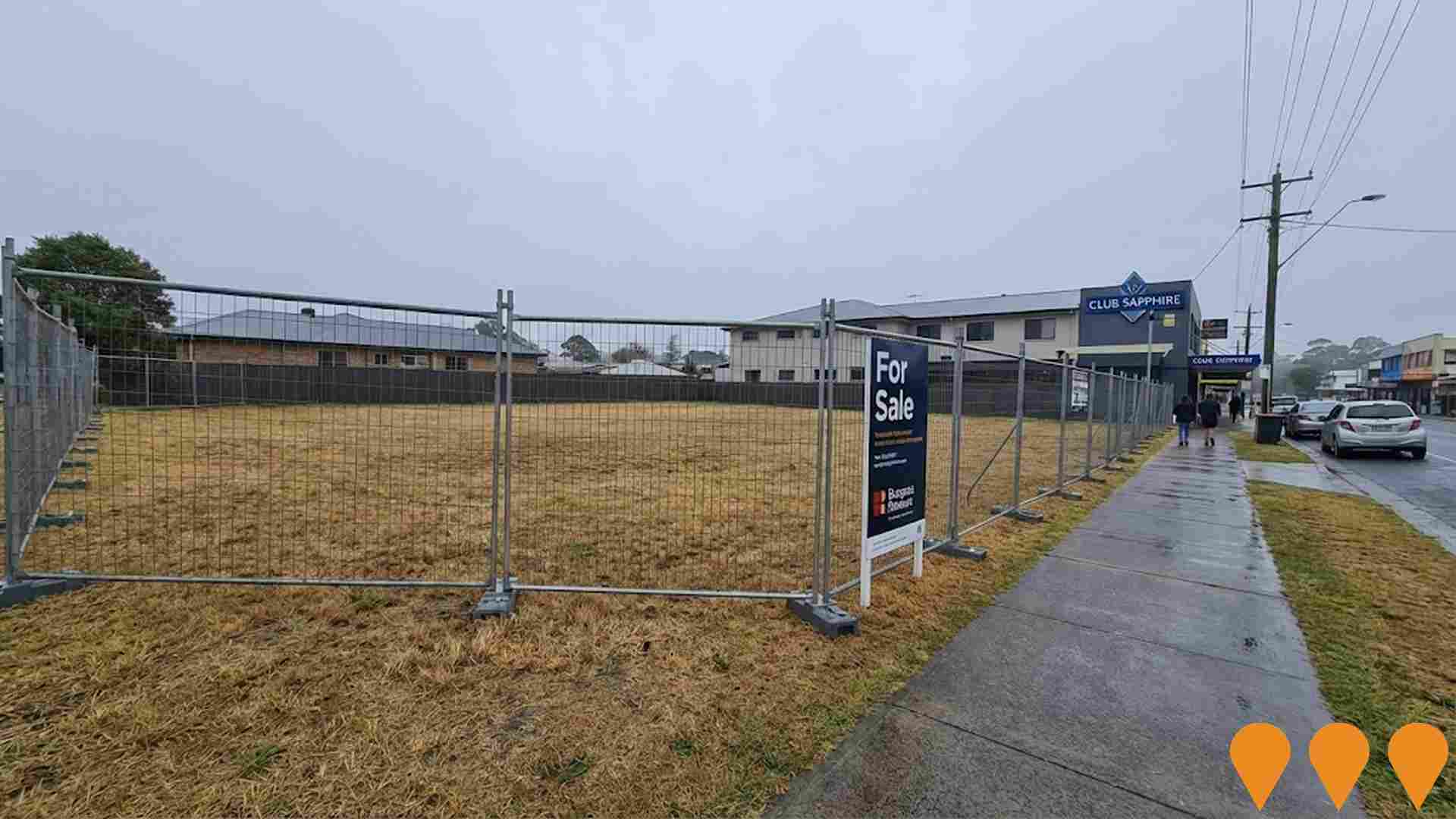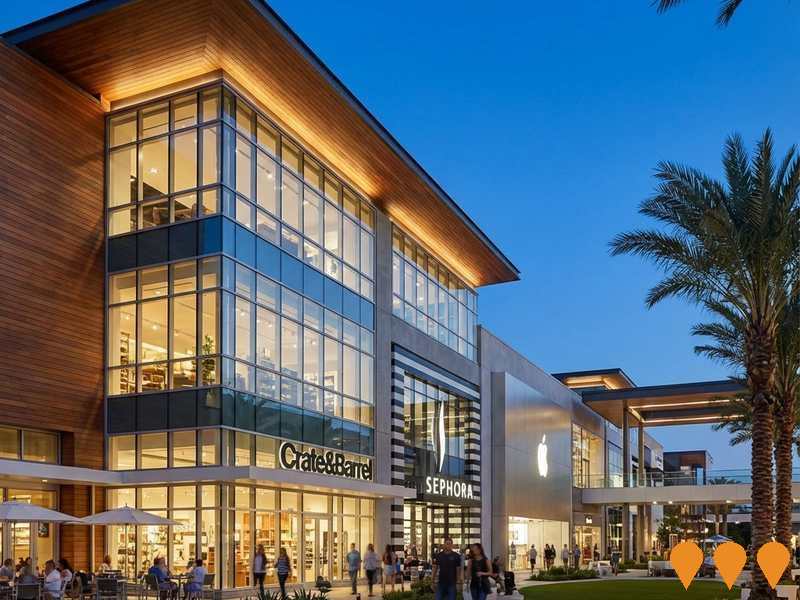Chart Color Schemes
est. as @ -- *
ABS ERP | -- people | --
2021 Census | -- people
Sales Activity
Curious about local property values? Filter the chart to assess the volume and appreciation (including resales) trends and regional comparisons, or scroll to the map below view this information at an individual property level.
Find a Recent Sale
Sales Detail
Population
Population growth drivers in Merimbula - Tura Beach are strong compared to national averages based on AreaSearch's ranking of recent, and medium to long-term trends
Merimbula - Tura Beach's population was 11,513 as of the 2021 Census. By November 2025, it is estimated to be around 11,635, an increase of 122 people (1.1%). This change is inferred from ABS data showing an estimated resident population of 11,617 in June 2024 and the addition of 80 validated new addresses since the Census date. The population density is approximately 119 persons per square kilometer. Over the past decade, the area has shown resilient growth with a compound annual growth rate of 1.0%, exceeding the SA3 area's growth rate. Interstate migration contributed around 62.6% of overall population gains during recent periods.
AreaSearch uses ABS/Geoscience Australia projections for each SA2 area released in 2024, based on 2022 data, and NSW State Government's SA2 level projections for areas not covered by this data, released in 2022 with a 2021 base year. Growth rates by age group are applied to all areas from 2032 to 2041. Nationally, non-metropolitan areas are projected to have above median population growth. By 2041, Merimbula - Tura Beach is expected to grow by 1,781 persons, a total gain of 15.1%.
Frequently Asked Questions - Population
Development
Recent residential development output has been above average within Merimbula - Tura Beach when compared nationally
Merimbula - Tura Beach has had approximately 253 dwelling approvals over the past five financial years, with around 50 dwellings receiving approval each year. As of FY-26, there have been 8 approvals recorded so far. On average, 1.4 new residents per year per dwelling constructed have been seen between FY-21 and FY-25. This indicates a balanced supply and demand market supporting stable conditions.
The average expected construction cost value for new dwellings is $387,000. In the current financial year, there have been $12.6 million in commercial approvals, demonstrating moderate levels of commercial development compared to other areas. Compared to the rest of NSW, Merimbula - Tura Beach has approximately 75% of the construction activity per person and ranks among the 71st percentile nationally. However, construction activity has intensified recently. The new building activity shows a shift towards compact living, with 49.0% detached dwellings and 51.0% medium and high-density housing.
This departure from existing housing patterns (currently 75.0% houses) suggests diminishing developable land availability and responds to evolving lifestyle preferences and housing affordability needs. The location has approximately 206 people per dwelling approval, indicating a low density market. It is projected to grow by 1,762 residents through to 2041. Development is keeping pace with the projected growth, though buyers may face increasing competition as the population expands.
Frequently Asked Questions - Development
Infrastructure
Merimbula - Tura Beach has moderate levels of nearby infrastructure activity, ranking in the 40thth percentile nationally
Changes to local infrastructure significantly influence an area's performance. AreaSearch identified 14 projects likely impacting the area. Notable ones include Templo Merimbula, Club Sapphire Hotel and Conference Centre, Lakewood Lifestyle Village, and Supercheap Auto and BCF Merimbula. The following list details those most relevant.
Professional plan users can use the search below to filter and access additional projects.
INFRASTRUCTURE SEARCH
 Denotes AI-based impression for illustrative purposes only, not to be taken as definitive under any circumstances. Please follow links and conduct other investigations from the project's source for actual imagery. Developers and project owners wishing us to use original imagery please Contact Us and we will do so.
Denotes AI-based impression for illustrative purposes only, not to be taken as definitive under any circumstances. Please follow links and conduct other investigations from the project's source for actual imagery. Developers and project owners wishing us to use original imagery please Contact Us and we will do so.
Frequently Asked Questions - Infrastructure
Wolumla Structure Plan
Adopted structure plan providing a strategic framework for the development of approximately 1,096 new dwellings across three major land holdings in Wolumla. The plan guides infrastructure provision including transport networks, utilities, and community facilities to integrate new residential areas with the existing village. Council secured $50,380 in funding in July 2025 to prepare an infrastructure contributions plan. The development will effectively triple Wolumla's population over an estimated 25-year timeframe and addresses housing shortage in the Bega Valley Shire.

Lakewood Lifestyle Village
An 86-unit seniors housing facility in Merimbula approved by the NSW Land and Environment Court following a deemed refusal by the Bega Valley Shire Council. The amended proposal includes independent living units, communal and recreational facilities, parking, and landscaping, with a reduced scale to address community concerns about height, bulk, and visual impact.

Club Sapphire Hotel and Conference Centre
Proposal for a 100-room, four-plus star hotel and conference facility, approximately five to seven storeys, to be built atop the existing Club Sapphire. The development is part of the club's strategy to diversify income streams and reduce reliance on gaming revenue. It requires a planning proposal to amend the maximum building height on the site from 16m to 21m or 26m. The concept development application (DA) is on hold pending the finalisation of the planning proposal.

Templo Merimbula
A luxury short stay hotel precinct, renamed 'Mati' by the developer, consisting of a hotel and 14 townhouses, plus a restaurant. The design uses the natural slope of the emerald hill to maximize ocean views from the living spaces, and incorporates endemic planting and durable materials to blend with the coastal environment. The project was Development Application approved in 2024.

Ocean Drive Townhouse and Apartment Complex
Development Application (DA2021.365) to be determined by the Southern Regional Planning Panel (PPSSTH-173) for a complex of 27 townhouses and 32 apartments with basement parking on a site at 63 Ocean Drive and 460 Arthur Kane Drive, Merimbula. Concerns have been raised regarding density, bulk, and scale of the development. Council assessment staff provided non-support of the application and requested it be withdrawn as of May 2023. A Public Determination Meeting was scheduled for July 28, 2023.

Mirador Residential Development Stages 8, 9 and 13
The proposed action is the final stages (8, 9, and 13) of the Mirador residential development, involving the clearing of approximately 21.39 ha of native vegetation on a 52.5 ha site for low-density housing lots and associated infrastructure. The development is subject to a Federal environmental assessment due to potential significant impacts on threatened species and habitat, including the long-nosed potoroo and Merimbula Star-hair. The development is anticipated to accommodate between 126 and 252 residents upon completion and has an estimated start date of January 2025.

Shearwater Estate
New residential land subdivision and construction of homes in central Tura Beach. The estate offers spacious residential lots ranging from 900m2 to 1500m2 on level ground. Infrastructure like roads, power, water, and sewage are being installed, and new homes are being built/sold, indicating the project is in the construction phase.

Club Sapphire Residential Development (DA Approved - Site For Sale)
A previously approved residential development for a four-storey complex with 40 luxury apartments and 68 car spaces on a 4,084sqm site. The project was put on hold due to rising construction costs and the site is currently being advertised for sale by the developer. The site has Development Approval (DA) for the 40-unit residential flat building and strata subdivision.

Employment
Despite maintaining a low unemployment rate of 2.9%, Merimbula - Tura Beach has experienced recent job losses, resulting in a below average employment performance ranking when compared nationally
Merimbula - Tura Beach has an unemployment rate of 2.9% as of June 2025, with 5,141 residents employed. This is below the Rest of NSW's rate of 3.7%.
Workforce participation in Merimbula - Tura Beach is 49.5%, compared to 56.4% in the Rest of NSW. Key industries are health care & social assistance, accommodation & food, and retail trade. The area has a strong specialization in accommodation & food, with an employment share of 1.7 times the regional level. However, mining shows lower representation at 0.2%.
Labour force decreased by 3.6% over a 12-month period ending June 2025, with employment declining by 4.6%, leading to a rise in unemployment rate by 1.0 percentage points. National employment forecasts from Jobs and Skills Australia project growth of approximately 6.4% over five years and 13.3% over ten years for Merimbula - Tura Beach, based on its current employment mix.
Frequently Asked Questions - Employment
Income
The area's income levels rank in the lower 15% nationally based on AreaSearch comparative data
Merimbula - Tura Beach's median income among taxpayers was $44,236 and average income stood at $57,377 in financial year 2022. This compares to Rest of NSW's figures of $49,459 and $62,998 respectively. By September 2025, estimates based on Wage Price Index growth of 12.61% would be approximately $49,814 (median) and $64,612 (average). Census data shows household, family and personal incomes in Merimbula - Tura Beach fall between the 16th and 24th percentiles nationally. Income distribution reveals that 28.7% of individuals earn between $1,500 and $2,999, consistent with surrounding regions at 29.9%. After housing costs, 86.0% of income remains, ranking at the 19th percentile nationally. The area's SEIFA income ranking places it in the 4th decile.
Frequently Asked Questions - Income
Housing
Merimbula - Tura Beach is characterized by a predominantly suburban housing profile, with ownership patterns similar to the broader region
In Merimbula - Tura Beach, as per the latest Census, 74.7% of dwellings were houses, with the remaining 25.4% consisting of semi-detached homes, apartments, and other types. In comparison, Non-Metro NSW had 84.3% houses and 15.7% other dwellings. Home ownership in Merimbula - Tura Beach stood at 51.3%, similar to Non-Metro NSW's rate. Mortgaged dwellings accounted for 26.3%, while rented ones made up 22.4%. The median monthly mortgage repayment was $1,600, above the Non-Metro NSW average of $1,517. Weekly rent in Merimbula - Tura Beach was $340, compared to Non-Metro NSW's $320. Nationally, mortgage repayments were lower than the Australian average of $1,863, and rents were less than the national figure of $375.
Frequently Asked Questions - Housing
Household Composition
Merimbula - Tura Beach features high concentrations of lone person households, with a lower-than-average median household size
Family households account for 64.9% of all households, including 19.4% that are couples with children, 37.3% that are couples without children, and 7.8% that are single parent families. Non-family households make up the remaining 35.1%, with lone person households at 32.5% and group households comprising 2.5% of the total. The median household size is 2.1 people, which is smaller than the Rest of NSW average of 2.2.
Frequently Asked Questions - Households
Local Schools & Education
Merimbula - Tura Beach shows below-average educational performance compared to national benchmarks, though pockets of achievement exist
Merimbula-Tura Beach has a university degree holder rate of 23.2% among residents aged 15 and above, compared to NSW's 32.2%. Bachelor degrees are the most common at 15.6%, followed by postgraduate qualifications (4.1%) and graduate diplomas (3.5%). Vocational credentials are held by 40.3% of residents aged 15 and above, with advanced diplomas at 11.3% and certificates at 29.0%. A total of 22.1% of the population is actively pursuing formal education, including 8.2% in primary, 6.9% in secondary, and 2.1% in tertiary education.
The four schools in Merimbula-Tura Beach have a combined enrollment of 1,419 students, with typical Australian school conditions (ICSEA: 992) indicating balanced educational opportunities. These schools include two primary, one secondary, and one K-12 institution.
Frequently Asked Questions - Education
Schools Detail
Nearby Services & Amenities
Transport
Transport servicing is low compared to other areas nationally based on assessment of service frequency, route connectivity and accessibility
Merimbula - Tura Beach has 202 active public transport stops, all of which are bus stops. These stops are served by 43 different routes that together facilitate 542 weekly passenger trips. The average distance from residents to the nearest transport stop is 164 meters, indicating excellent accessibility.
On average, there are 77 trips per day across all routes, resulting in approximately two weekly trips per individual stop.
Frequently Asked Questions - Transport
Transport Stops Detail
Health
Health performance in Merimbula - Tura Beach is well below average with prevalence of common health conditions notable across both younger and older age cohorts
Health data indicates significant challenges for Merimbula - Tura Beach, with high prevalence of common health conditions across both younger and older age groups. Private health cover stands at approximately 48%, covering around 5,619 people, which is lower than the national average of 55.3%.
The most prevalent medical conditions are arthritis (affecting 12.6% of residents) and mental health issues (impacting 8.4%). A total of 59.9% of residents claim to be free from any medical ailments, slightly higher than the Rest of NSW average of 59.6%. The area has a notably older population, with 34.0% being aged 65 and over (3,959 people), compared to 31.7% in Rest of NSW.
Frequently Asked Questions - Health
Cultural Diversity
Merimbula - Tura Beach is considerably less culturally diverse than average when assessed alongside AreaSearch's national rankings for language and cultural background related metrics
Merimbula-Tura Beach showed lower cultural diversity, with 84.5% born in Australia, 91.1% being citizens, and 96.0% speaking English only at home. Christianity dominated at 48.0%. Judaism was slightly overrepresented at 0.1%, compared to the Rest of NSW's 0.1%.
The top three ancestral groups were English (34.5%), Australian (29.0%), and Irish (9.4%). Dutch, Scottish, and Welsh showed notable divergences in representation: Dutch at 1.6% vs regional 1.4%, Scottish at 8.7% vs 8.6%, and Welsh at 0.6% vs 0.5%.
Frequently Asked Questions - Diversity
Age
Merimbula - Tura Beach ranks among the oldest 10% of areas nationwide
Merimbula - Tura Beach has a median age of 53, which is higher than Rest of NSW's figure of 43 and significantly exceeds the national norm of 38. Compared to Rest of NSW, Merimbula - Tura Beach has a higher proportion of residents aged 65-74 (17.6%) but fewer residents aged 5-14 (9.0%). This concentration of 65-74 year-olds is well above the national figure of 9.4%. Between the 2021 Census and the present, the proportion of residents aged 75 to 84 has grown from 10.9% to 12.2%, while those aged 35 to 44 increased from 8.7% to 9.9%. Conversely, the proportion of residents aged 55 to 64 has declined from 16.3% to 14.3%, and the 65 to 74 group has dropped from 18.7% to 17.6%. By 2041, demographic projections indicate significant shifts in Merimbula - Tura Beach's age structure. Notably, the 85+ group is projected to grow by 101%, reaching 973 people from a current figure of 484. Meanwhile, the 15 to 24 cohort is projected to decline by 26 people.



